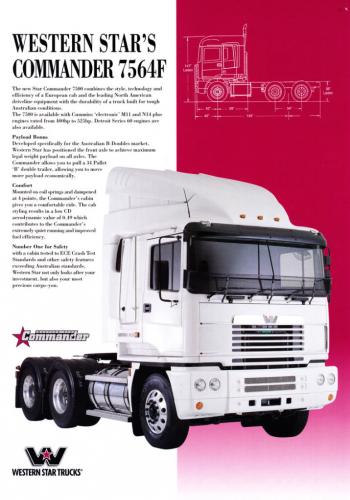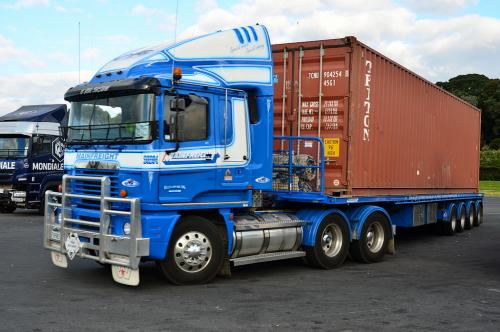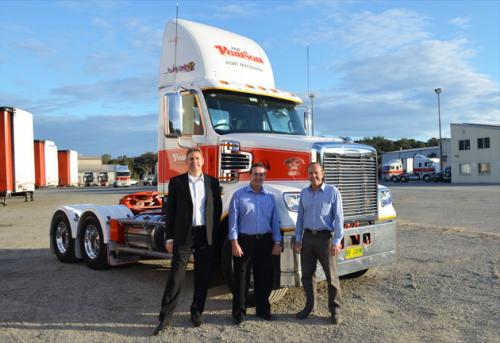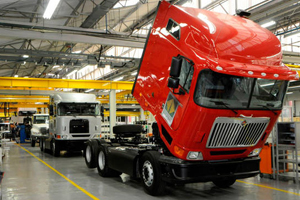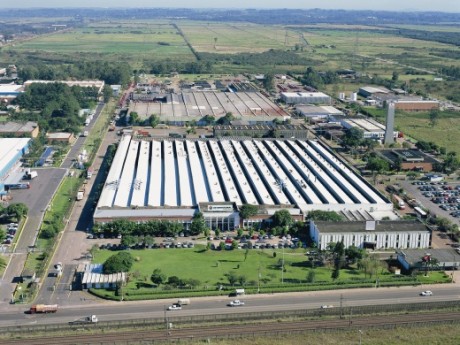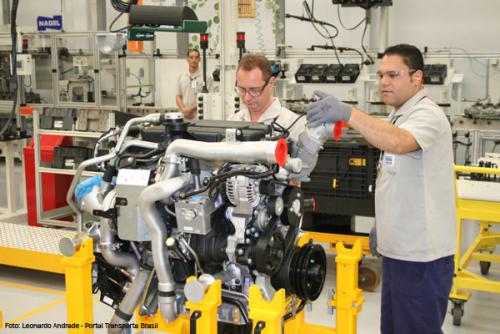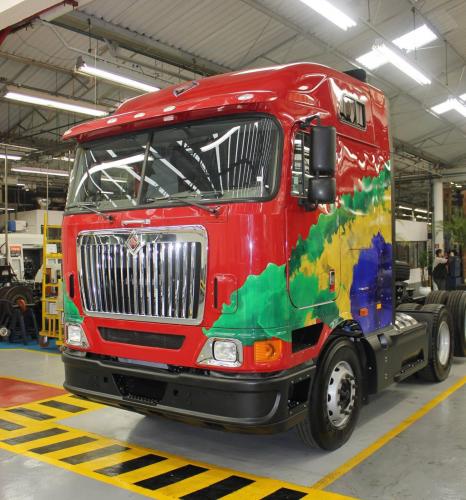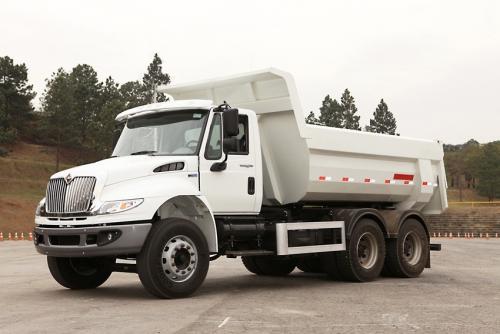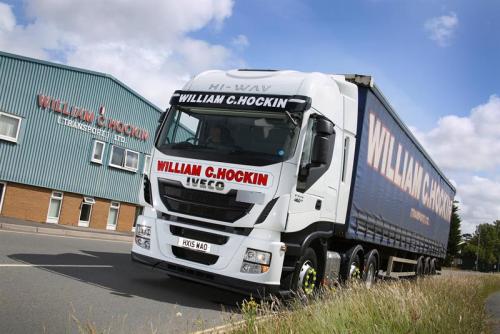
kscarbel2
Moderator-
Posts
18,918 -
Joined
-
Days Won
114
Content Type
Profiles
Forums
Gallery
Events
Blogs
BMT Wiki
Collections
Store
Everything posted by kscarbel2
-
See That Glowing Truck? It’s Using Plasma to Save Fuel
kscarbel2 replied to kscarbel2's topic in Trucking News
Glow-in-the-dark trucks use plasma to reduce drag and save fuel New Scientist / July 22, 2015 You’re driving down the motorway at night when you pass a truck that’s glowing purple. Don’t worry, it isn’t leaking toxic chemicals: it just has a clever way of reducing drag by using plasma. Trucks are sometimes fitted with devices such as spoilers to reduce drag. Panels underneath the body are known as “side skirts”, while “rear tail fairings” are fitted to the back. Billions of dollars in fuel could be saved annually if they were fitted to every truck in the US alone, but the devices have drawbacks. They sometimes need to be removed for loading, for example. “They are only good for one speed range and they might contribute to drag in other speed ranges,” says Pranay Bajjuri, co-founder of Plasma Stream Technologies in Bettendorf, Iowa. “They are bulky and the additional weight directly impacts on fuel efficiency.” So he and his colleagues are working on making trucks more aerodynamic by using plasma actuators, which would be fitted in place of spoilers and fairings. These are essentially two copper plates separated by a layer of Teflon, developed at the University of Notre Dame in Indiana, where researchers have been working on trying to reduce drag on aeroplanes. When a current is passed through the actuators, they produce charged plasma, which affects airflow. This delays flow separation, where the airflow detaches from the vehicle’s surface and becomes turbulent, producing drag. The actuators would turn on and off as needed, controlled by a speed sensor. Bajjuri claims that a plasma actuator system for a truck would cost about $2500 and should give fuel savings of around 15 per cent, paying for itself in months. Actuators don’t need to be removed every time the truck is loaded and unloaded and can even be painted. The only side effect is the faint purple glow. The aerodynamics of trucks is bad, says Hyeok-bin Kwon of the Korea National University of Transportation in Chungju, whose own work uses plasma to streamline high-speed trains. Fortunately it’s easier to reduce drag on a truck than on a train, he says, because there are so many are many shape modifications you can use. Bajjuri’s team is working to optimise the system for trucks before wind tunnel tests later this year. -
Heavy Duty Trucking / August 7, 2015 A new generation of aerodynamic improvements for tractor-trailers to reduce fuel consumption is being tested and if you see one you can tell by how its glowing. New Scientist magazine reports Iowa-based Plasma Stream Technologies Inc. is fitting trucks with plasma actuators, devices that control aerodynamic flow, rather than fuel saving devices you see on tucks these days, such as side skirts and trailer tails. According to the company: These are essentially two copper plates separated by a layer of Teflon, developed at the University of Notre Dame in Indiana, where researchers have been working on trying to reduce drag on airplanes. When a current is passed through the actuators, they produce charged plasma, which affects airflow. This delays flow separation, where the airflow detaches from the vehicle’s surface and becomes turbulent, producing drag. The actuators would turn on and off as needed, controlled by a speed sensor. Pranay Bajjuri, co-founder of Plasma Stream Technologies, told the magazine equipping a truck with such a system runs about US$2,500 but results in fuel savings of 15 percent. Trucks equipped with them usually exhibit a glow. Related reading - http://plasmastreamtech.com/technology/
-
Tim, here is the beautiful Western Star-branded model 7564 COE which was produced by UK truckmaker ERF. Nice truck. Quite a few were sold in New Zealand such as this stunning Mainfreight unit. It was based on the ERF model EC and featured the company's signature fiberglass panel-over-steel frame cab architecture. ERF had been taken over by Canada (British Columbia) based Western Star in 1996. MAN bought ERF in March 2000, and Daimler-Chrysler acquired Western Star in August 2000. .
-
Prime Mover Magazine / August 9, 2015 New South Wales-based, Jim Pearson Transport, has recently taken delivery of its 200th Freightliner truck since its first purchase in 2003. “Freightliner continues to be my provider of choice because of their consistent performance,” said owner, Jim Pearson. “Our decision to buy from Freightliner 12 years ago was driven by the need to work with a manufacturer that was as committed to driver comfort and tare weight as well as the availability of commonly used componentry and support I receive from my local dealer.” To mark the milestone, representatives from both Freightliner and truck dealership, Mavin Truck Centre, attended the handover at the company's Port Macquarie headquarters. “When the order for the 200th truck came in, we knew it was important to come to Port Macquarie and say thank you in person,” said Stephen Downes, General Manager for Freightliner Trucks Australia. "Purchasing 200 trucks, let alone 200 Freightliners in 12 years from the one dealership is a significant achievement for a regional company like Jim Pearson Transport. It demonstrates both the exceptional quality of the Freightliner product and Mavin Truck Centres’ commitment to providing great product support." Dean Mavin, Dealer Principle of Mavin Truck Centre, added, “Reaching this goal recognises our unwavering focus on exceeding our customers' expectations when they purchase Freightliner vehicles,” he said. “It also highlights Jim’s loyalty and commitment to his local community. A lot of local suppliers have grown as a result of the support they receive from Jim Pearson Transport.” .
-
Spoke to hub pilot hub swap brake drum part number?
kscarbel2 replied to BucketTrucker688's topic in Air Systems and Brakes
Your desire should be a cut-and-dry matter rather than a mystery. Unless Volvo has terminated Mack procedure, your Mack dealer would submit a changeover request with your truck's model and serial number to the specifications department at parts operations. The dealer would then be provided a list of the parts required (and/or the related mounting arrangements) to perform the changeover (ie. the parts the factory would have used had your truck been originally ordered that way), and you would then order the parts..........without any doubts whatsoever. -
Man executes family of 8 in Texas Associated Press / August 9, 2015 A family of six children and two parents were restrained and fatally shot in the head at a Houston home by a man with a violent criminal history who had previously been in a relationship with the mother, authorities said Sunday. David Conley, 48, was charged with capital murder in the deaths. Conley, who is being held in Harris County Jail, didn't appear at a court hearing Sunday where an arrest affidavit was read. The judge denied him bond. The dead were identified as parents Dewayne Jackson, 50, his wife Valerie Jackson, 40, and children Nathaniel, 13, Dewayne, 10, Honesty, 11, Caleb, 9, Trinity, and Jonah, 6. Nathaniel was believed to be Conley's son from the relationship with Valerie Jackson. "We do not — cannot — fully comprehend the motivation of an individual that would take the lives of so many innocent people. Especially the lives of the youngest," Harris County Chief Deputy Tim Cannon said. "The killer's motives appear to be related to a dispute with Valerie, who was a former domestic partner." Conley told police that he discovered on Saturday morning that the locks had been changed at the home after he had moved out. He entered the home through an unlocked window, according to the affidavit. Officials with the Harris County Sheriff's Office later responded to a request to do a welfare check at the house and got no response at the door. They saw through a window a male on the floor with a gunshot wound. Police then heard gunshots coming from the front of the house. A standoff ensued between officers and Conley. He later gave himself up to authorities and was arrested. Court records show Conley's criminal history dates back to at least 1988, with the most recent incident last month, when was charged with assault of a family member. In court documents, authorities say the suspect had been arrested for allegedly assaulting the woman he was living with at the home where the bodies were found. Documents say he was in a dating relationship with the woman. It was not immediately clear if the woman in the previous incidents was Valerie Jackson. Court documents said Conley pushed the woman's head against a refrigerator multiple times after she tried to stop him from disciplining her son with a belt. The case was still pending. In 2013, he was charged with aggravated assault for threatening the same woman with a knife. He pleaded guilty and was sentenced to nine months in the county jail. In 2000, he was arrested for retaliation, accused of putting a knife to his then-girlfriend, threatening to kill her, her baby and himself. That came after she filed an assault charge against him for cutting her with a knife and punching her in the face. He was sentenced to five years in prison for retaliation.
-
Tim Maikshilo isn’t fooling me - It's the Vegemite
kscarbel2 replied to kscarbel2's topic in Odds and Ends
An act of pure sacrilege, the Australian government suggests Vegemite sales be limited BBC / August 9, 2015 Australia's government says some communities should consider limiting the sale of the popular Vegemite spread because it is being used to make alcohol. It says the yeast-based product is contributing to anti-social behaviour in some remote communities. Indigenous Affairs Minister Nigel Scullion described the salty spread as a "precursor to misery". He said it was being bought in bulk to make moonshine. Brewer's yeast is a key ingredient in the spread and is used in the production of beer and ale. In communities where alcohol is banned because of addiction problems, Mr Scullion said Vegemite sales should also be restricted. "Businesses in these communities... have a responsibility to report any purchase that may raise their own suspicions," he said. The minister added that in some cases, children were failing to turn up to school because they were too hung-over, and that Vegemite was an increasingly common factor in domestic violence cases. But Dr John Boffa of the People's Alcohol Action Coalition, who is based in Alice Springs, in Australia's Northern Territory, says the problem is not widespread. "We're talking about an isolated problem in a couple of communities around a very large nation, and a nation where there is a very large number of Aboriginal communities, and every community is different," he told the BBC. He said there might be a need for some local initiatives, but that these should be initiated by the communities themselves. Vegemite started as a war-time substitute for Marmite, and is now something of an Australian culinary icon, says the BBC's Jon Donnison in Sydney. http://www.bbc.com/news/world-australia-33839742 ------------------------------------------------------------------------------------------------------ Note that the government did not suggest that UK-produced Unilever Marmite or New Zealand-produced Sanitarium Marmite sales be curbed. The plot thickens……………… Alcohol can also be produced from potatoes, corn, wheat and rye. Shall Australia ban these common every day items as well? Indigenous Affairs Minister Nigel Scullion should be brought up on charges for insulting the good name of a national icon. With this news, I'm stocking up on Vegemite when I pass thru HK this week. -
Navistar struggles to continue manufacturing in Brazil
kscarbel2 replied to kscarbel2's topic in Trucking News
FYI: Brazilian market (left-hand drive) International 9800i Pro Sleeper review -
Automotive Business / August 5, 2015 Navistar’s Canoas plant may soon be producing Chinese trucks. With the drastic slow down in production at Navistar’s Brazilan Canoas plant, rumors have been circulating that the facility could close as early as the beginning of 2016 if new business is not acquired. Currently, the 700 employee plant is assembling 4400i (Durastar) medium and medium-heavy trucks, and 9800i 6x4 heavy tractors, as well as assembling General Motors 2.8 liter Duramax diesel engines under contract. Last week, metalworkers union president Paul Chintolina informed workers that the GM engine contract would end two years early, in February 2016. Chintolina also announced that Navistar plans to relocate Canoas’ function as Navistar’s Brazilian spare parts distribution center (PDC) for truck and engine parts to the MWM International engine plant in São Paulo. He said, with that change, there was little chance of truck production surviving at Canoas with just two products being produced in extremely low volumes. Navistar officials have refused to comment. Navistar has spoken with China’s JAC on assembling their light commercial trucks under contract at Canoas. Navistar and JAC have been discussing many forms of possible cooperation in China since 2011. Talks finally came to a head this May, and JAC decided to pass owing to Brazil's imploding truck market. In Brazil, foreign truckmakers must realistically assemble trucks from CKD (completely knocked down) kits in order to avoid high import tariffs on SKD (semi-knocked down) kits and CBUs (completely built units). JAC entered the Brazilian market in 2011 selling cars and light commercial trucks, and established a local car plant in 2014. Navistar has also held talks with Chinese heavy truck maker Sinotruk, but discussions ended with the Brazilian market downturn. Navistar, trying to promote its Canoas plant as a low cost manufacturing option, has also been talking with Beijing-based light, medium and heavy truckmaker Foton. The Chinese truckmaker had announced plans in 2013 to build a truck plant in Rio Grande do Sul, beginning production in 2016. However, the deal has been held up due to problems with land donation and funding of the US$70.7 million project. In an interview last week, Foton Brazil director Luiz Carlos Paraguassu acknowledged the projects long running delay and said truck production would finally start in the beginning of 2016, even if in a temporary facility, because the company must commence production by that time or lose its tax-exempt status. Navistar’s Canoas plant would provide Foton with an inexpensive, if not temporary, solution. Cooperation with Foton may be the only viable way for Navistar to keep its Brazilian truck production line open in Canoas. About 150 of the facilities 700 employees work on the truck assembly line.. During the first half of 2015, only 50 new International trucks were sold and registered in Brazil. Related reading - http://www.bigmacktrucks.com/index.php?/topic/38944-is-the-end-near-again-for-navistar-in-brazil/?hl=canoas .
-
Automotive Business / August 5, 2015 General Motors has confirmed that it will end its engine manufacturing agreement next year with Navistar’s MWM International Motores diesel engine operation in Canoas, Brazil. MWM International has been producing 2.8 liter Duramax diesel engines under license for GM which are used in the Latin American market S10 pickup and Trailblazer SUV, and now in the new U.S. market Chevrolet Colorado and GMC Canyon. GM says the agreement will end in February 2016, at which time production will be transferred to one of GM’s own Brazilian plants. GM originally awarded MWM International the 2.8 liter Duramax diesel engine contract in July 2008, with deliveries beginning in November 2011, coinciding with the arrival of the next generation GM global market pickup, and run to 2018. At the time, MWM International president and CEO Waldey Sanchez said the company would invest US$80 million at its plants in Canoas (Rio Grande du Sul) and Santo Amaro,(São Paulo) in Brazil; and Jesus Maria in Argentina; and create 400 new jobs to meet the requirements of the GM contract. From 1964 to 2008, International MWM produced almost 780,000 engines under contract for GM trucks, pickups and SUVs. The new-for-2015 U.S. market Chevrolet Colorado and GMC Canyon is based on the new-for-2011 global market Chevrolet Colorado produced in Thailand and Brazil GM produces 2.8-liter Duramax diesel engines for Thai production at its own engine plant in Thailand. When the launch of the new Colorado (badged S-10) and Trailblazer in Brazil, the engine contract was hailed as the largest in the history of MWM International. Engine volumes were expected to reach 60,000 units annually. Neither company will comment on why the agreement will end two years early. Currently, GM only produces flex-fuel ethanol engines in Brazil at two plants: São José dos Campos and Joinville. Production began in 2013. The S-10 and Trailblazer are manufactured at GM’s San Jose plant. Related reading: http://www.chevrolet.com.br/ http://en.chevrolet.co.th/cars/trailblazer/model-overview.html http://www.mwm.com.br/site.aspx/Home-En
-
Transport Engineer / August 7, 2015 Barnstable, Devon based haulier William C Hockin (Transport) has taken delivery of its first Iveco trucks – two Euro 6 Stralis Hi-Way 6x2 twin-steer (AS440S46TXP) tractor units. The Stralis tractors join the company's fleet of more than 100 commercial vehicles and initial feedback has been "good". "We had heard good reports of the Stralis Hi-Way so were keen to run our own evaluation," states managing director Bill Hockin. "Initial reports have been encouraging with good results on the fuel front, even when taking into account that the vehicles are still new," he continues. "We carry out all our own maintenance, and operations to date have been trouble free.... Coupled with positive comments from the drivers, it's made for a very encouraging start." Each of his Stralis tractor units was specified with the Cursor 11 460bhp engine (which delivers 2,150 Nm of torque between 925 and 1,500rpm) matched with Iveco's standard EuroTronic (ZF) automated transmission. Efficiency should be good, since the Stralis Hi-Way has Iveco's patented HI-SCR (selective catalytic reduction) system, which meets Euro 6 emissions standards without exhaust gas recirculation (EGR). Iveco makes the point that, as a result, there is no requirement for increased engine cooling capacity, nor for active regeneration in the DPF (diesel particulate filter). This helps to deliver weight reduction and impressive fuel performance, says the firm, while the simplicity of the SCR-only approach means long service intervals for the DPF of up to 600,000km. "As the vehicles get more miles under their belt we will be better placed to evaluate the total cost of ownership," comments Hockin. "That's the number one consideration when running a large heavy truck fleet as intensively as we do, and was the key driver in us ordering our first Iveco vehicles." Delivered by dealer Hendy Van & Truck, the new vehicles will trunk more than 130,000 km per year operating with a mix of curtainsiders, flatbeds and tankers. Related reading - http://www.iveco.com/uk/products/pages/stralis-hi-way-hi-profitability.aspx .
-
Transport Engineer / August 7, 2015 ContiTech has developed cold-resistant air springs – based on a novel rubber compound – for trucks and semi-trailers running in extremes of temperature. According to Diethelm Bauch, head of commercial vehicle original equipment at ContiTech Air Spring Systems, the new units remain elastic even at the lowest temperatures. "Conventional air springs lose their elasticity at low sub-zero temperatures and can develop leaks," states Bauch. "With the new air spring, trucks are optimally equipped to operate in temperatures as low as -55°C / -67°F," he says, adding that the new bags are badged with a distinctive snowflake symbol, as used on Continental winter tyres. Bauch says Conti's first generation air springs have already proved successful in Siberia, and that the company has now brought out more variants – as well as versions for high temperatures up to 80°C / -176°C (bearing a sun symbol). Bauch makes the point that ContiTech operates its own laboratories worldwide as well as a certified test centre in Hanover (Germany), which was used to simulate not only heat and cold but also road tests. "This reduces development times and strengthens our role as a development partner," he explains. "Our decades of experience in regions with extreme climates and our extensive knowledge in development set us apart. "As such, we are experiencing an ever-increasing demand from commercial vehicle manufacturers for these high-tech products."
-
Prime Mover Magazine / August 6, 2015 As a result of fuel tax indexation, the fuel tax credit rate for fuel purchased for on-road use in eligible heavy vehicles increased from 12.76 cents per litre to 13.06 cents per litre on 1 August 2015. The fuel tax credit rate for powering auxiliary equipment also increased, from 38.9 cents per litre to 39.2 cents per litre. Operators will need to claim different fuel tax credit rates for fuel acquired before and from this date. According to the Australian Trucking Association (ATA), the ATO recommends that all operators use its online Fuel tax credit calculator to get fuel tax credit rates correct for your BAS. The calculator is also available on the ATO app. To find out more about these changes, visit the ATO's fuel schemes rates page.
-
Transport Topics / August 6, 2015 Navistar said its competitors have declined to participate in a fuel-economy challenge the manufacturer proposed last month to be held at its proving ground in Indiana. “International Truck has a long history of conducting competitive vehicle testing, and we still believe transparent, head-to-head testing using industry-recognized methodology of similarly spec’d competitive models is the most objective means to benchmark performance. It enables truck manufacturers to design better vehicles and allows customers to make more informed decisions,” the company said in a statement. The test would have compared fuel economy of each company’s best performing Class 8 truck against Navistar’s International. The showdown was scheduled to take place at the manufacturer’s new proving grounds in New Carlisle, Indiana, during the week of Aug. 31. Navistar said that, despite the rejection of its challenge, the company remains confident in the fuel economy and uptime of its current generation of vehicles. “Testing grounds and proving grounds are great for specific testing of vehicles — for specific performance attributes — but it does not represent the real conditions our trucks run in with our customers,” Diane Hames, Daimler Trucks North America’s general manager of sales and marketing, said July 27 about the challenge. The test would have been for on-highway sleeper model-year 2016 trucks with only factory-installed options allowed, including hardware, software and fluids. “We’re all proud of our trucks, and I believe that running our vehicles in an open and transparent forum, side by side, will not only raise the watermark but will also benefit each of our customers in this industry,” Navistar Senior Vice President Jeff Sass previously said in a statement.
-
For those who value the gained insight that historical knowledge inherently yields, this is a good read. https://foreignpolicy.com/2015/08/05/stalin_japan_hiroshima_occupation_hokkaido/ https://foreignpolicy.com/2013/05/30/the-bomb-didnt-beat-japan-stalin-did/
-
Car & Driver / August 2013 Looks good on paper, feels better in person. Little has changed since we got our first shot at the Ram 1500 EcoDiesel: The Donald’s coiffure remains a triumph of applied engineering, artisanal toast inexplicably is still a thing, and Ram remains the only full-size, half-ton pickup to offer a diesel. Soon, however, there will be new competition, albeit indirect. Nissan’s 2016 Titan XD tweener is scheduled to hit showrooms later this year packing a Cummins diesel V-8, and GM’s slightly smaller Chevy Colorado/GMC Canyon twins are adding a diesel four-cylinder for 2016. For now, though, the Ram has the full-size, light-duty segment to itself. By the Numbers Ram announced late last year that 20 percent of all 1500 pickup production capacity—fully twice the projected figure—was dedicated to the EcoDiesel, and it remains higher than 15 percent. That statement should come as little surprise, as diesels typically offer two things truck buyers covet: torque and efficiency. As for the former, the Ram’s 3.0-liter turbocharged EcoDiesel V-6 cranks out 420 lb-ft at a relatively low 2000 rpm, ideal for doing truck stuff like towing, hauling, and crawling around in four-wheel-drive low-range while off-road. By comparison, Ram’s 3.6-liter Pentastar V-6 is rated at 269 lb-ft, the big-dog 5.7-liter Hemi at 410 lb-ft. Although the diesel’s 240 horsepower can’t match the 305- and 395-hp figures of the gasoline V-6 and Hemi V-8, you’d never know it based on around-town driving. The diesel’s low-end grunt makes quick work of motivating all 5688 pounds of a 19-foot-long Crew Cab 1500 like our test model. Rated to tow an SAE J2807-certified 8560 pounds, the EcoDiesel bests an equivalent 1500 3.6-liter, which is rated for 7180 pounds. Option a Ram 1500 Crew Cab with the Hemi, however, and you can tow up to 10,150 pounds. (At that point, however, many shoppers with that much to lug might be tempted to just move up to a three-quarter- or one-ton diesel-powered machine like a Ram 3500, Ford Super Duty, or Chevy Silverado 3500 HD.) While these numbers accurately reflect capability, it’s easy to lend too much credence to paper victories when comparing trucks. Based on our real-world experience, the EcoDiesel’s torque and its linear response make it a perfect partner for truck duty regardless of payload. As for efficiency, the situation is a bit more complicated. Choosing the diesel option in the Ram 1500 will cost you $4960 over the base Hemi V-8 with a six-speed automatic, $4270 more than the V-6 with the eight-speed auto, and $3120 more than a Hemi with the eight-speed. For that sum, you not only get the 3.0-liter V-6 oil-burner, but also a 230-amp alternator, 800-amp battery, max-duty engine cooling, a 26-gallon fuel tank, and a 3.55:1 rear axle. The diesel also requires an upgrade to the 8HP70 eight-speed automatic, for $500. So you’re in for nearly $5K before you burn through your first tank of diesel fuel. Our test truck came equipped with the provocatively named Big Horn package ($1205), which brings a Class IV trailer hitch, an electric-shift transfer case, fog lamps, bright exhaust tips, a power driver’s seat, a leather-wrapped steering wheel with audio controls, a folding rear seat, and a 115-volt AC outlet. Swapping in a 3.92:1 rear axle ($50) for the aforementioned 3.55:1 unit and adding front and rear rubber floor mats ($80) barely nicks the beer fund. Chrysler’s familiar Uconnect system ($1005) with the 8.4-inch screen and the usual complement of services (AM/FM/SiriusXM with Bluetooth, plus USB, SD, and auxiliary inputs) handles the infotainment chores. Our truck came with the 17-inch chrome wheel option instead of 20-inchers, triggering a $500 credit. In all, the extras added $6610, bringing the total price to $47,555. MPG and MPH With EPA ratings of 19 mpg city and 27 highway, the Ram 1500 EcoDiesel tops the 16/23 estimates for the V-6 1500 Crew Cab and the 15/21 numbers for the same truck with the 5.7-liter Hemi and eight-speed auto. In our hands, the EcoDiesel returned 21 mpg in combined driving. We did witness an indicated 29 mpg on long, flat stretches of expressway at 65 mph in neighboring states with notoriously stringent speed-enforcement policies. (Hello, Cleveland!) Conversely, we were a little more aggressive with the accelerator pedal around town than the average owner is likely to be. Even so, when considered against the 15 mpg we saw in our test of a 2013 Ram 1500 V-6 and the 17 mpg of our 40,000-mile, long-term Ram 1500 Crew Cab V-6, the EcoDiesel’s 22 mpg is an impressive number. Somewhat less impressive is the zero-to-60-mph number, with the EcoDiesel taking 9.0 seconds, a full 1.2 longer than our departed long-term V-6 Ram. The quarter-mile measure fared similarly, the EcoDiesel’s 16.9-second time lagging slightly behind the long-termer’s 16.0-second run. Neither is going to win many races, but where the gasoline V-6 sometimes feels strained, the EcoDiesel just powers through, as if saying to the driver, “Yeah, what else ya got?” The wild card here, of course, is the Ford F-150 3.5-liter EcoBoost. Not content to simply match the EcoDiesel’s 420 lb-ft of torque, the twin-turbo EcoBoost V-6 keeps 365 horsepower on tap, sufficient to knock out a 14.4-second quarter-mile time, as measured in our testing. At the same time, however, the Ford returned just 16 mpg in combined driving. Interestingly, despite an aluminum-intensive construction, the 2015 F-150 Crew Cab EcoBoost 4x4 we tested weighed in at 5577 pounds, just 111 pounds fewer than the Ram 1500 EcoDiesel. It’ll take plenty of research to determine if dropping the extra coin on the Ram 1500 EcoDiesel will pencil in your favor. Your type of driving, payloads, trailering, annual mileage, and the cost of diesel in your area all will factor into the equation. However, no spreadsheet can illuminate how right the EcoDiesel feels from the driver’s seat. Photo Gallery - http://www.caranddriver.com/photo-gallery/2015-ram-1500-4x4-ecodiesel-4x4-test-review#1
-
The police are withholding crime scene photographs as evidence. Why not have used a stun gun? But I did read this: Was Zachary Hammond shot from behind? During an undercover marijuana bust, a South Carolina police officer says the 19-year-old teen was driving a car and appeared to be veering toward the officer as if Hammond intended to run him over. The police officer says he shot and killed the teen in self-defense, but the family claims the autopsy proves the cop shot Zachary Hammond from behind. The unidentified South Carolina police officer said he feared for his life when Hammond allegedly started driving his vehicle at the cop. The officer was approaching the car with his gun drawn, so he opened fire, killing the teen. The reason the family feels that the police officer shot Zachary Hammond from behind is due to the autopsy report. According to the Associated Press, Oconee County Coroner Karl Addis says the teen died from a gunshot wound to the upper torso, but he did not indicate whether the shooting took place from behind or in front. Attorney Eric Bland claims the first shot hit Hammond in the left rear shoulder and the second bullet hit at a downward angle into his side from the rear, piercing the teen’s heart and lungs. “The shots were so close in proximity to each other that it would be physically impossible unless the car was stopped and the officer came up very close to an open window,” Bland said. “Picture a car going 20 miles an hour and I’m fortunate enough to get a shot off, and I hit you — there’s no way I can get the second shot if the car’s going 20 miles an hour.”
-
Computer hacker’s demonstrate they can take control of vehicles
kscarbel2 replied to kscarbel2's topic in Trucking News
This is all a scam in the making, designed to shift billions of dollars of liability away from the vehicle manufacturers onto security software suppliers who have no liability as they make no promises of 100 percent guaranteed effectiveness. The vehicle manufacturers will most likely succeed with their scheme, because people have long accepted paying money from their own pocket to provide their computers with security software. In the end, the vehicle manufacturers will have rid themselves of the cost of providing security software with the car as a factory package, and most importantly in the cost perspective, rid themselves of the security responsibility and liability (it will be in the fine print when you buy the vehicle). -
How could deciding not to go through with the deal damage our credibility abroad? As anyone here that travels abroad knows, our reputation abroad is in the gutter. We are a laughing stock. Our state department from back in the Bush era has all but destroyed the very high levels of credibility that our country once enjoyed. Obama recently said the U.S. is “the key factor in ensuring stability and security in the world". We certainly were, but not at this point in time.
-
Tim Maikshilo isn’t fooling me - It's the Vegemite
kscarbel2 replied to kscarbel2's topic in Odds and Ends
The states doesn't get real Cadbury. Hershey's has a license agreement to produce/sell product under the Cadbury name in the states. It's a completely different tasting chocolate from the real Cadbury chocolate produced in the UK. I can't stomach the Hershey's Cadbury product. -
The Washington Post / August 6, 2015 Zachary Hammond was on a first date when he was fatally shot by a police officer in his car during a drug bust in South Carolina, his family says. At the time the 19-year-old was shot and killed, his date, Tori Morton, was eating an ice cream cone, according to the family’s attorney, Eric Bland. Morton, 23, was arrested and charged with possession of marijuana — all 10 grams of it — which, according to police, was the reason undercover agents set up the drug buy. The official police report never mentioned the two gunshots that killed Hammond on July 26 in a Hardees parking lot. Amid heightened scrutiny of fatal police shootings across the country, Hammond’s death has prompted numerous questions, few answers — and almost no national outrage. More than a week after Hammond’s death, his family’s attorney says race is almost certainly playing a role in the disconcerting silence. Unlike the victims in the highest-profile police shootings over the past year — in cities from Ferguson and Cleveland to North Charleston and Cincinnati — 19-year-old Zachary Hammond was white. “It’s sad, but I think the reason is, unfortunately, the media and our government officials have treated the death of an unarmed white teenager differently than they would have if this were a death of an unarmed black teen,” Bland told The Washington Post this week. “The hypocrisy that has been shown toward this is really disconcerting.” He added: “The issue should never be what is the color of the victim. The issue should be: Why was an unarmed teen gunned down in a situation where deadly force was not even justified?” So far this year, 25 percent of the people shot dead by police have been black, according to data collected by the Washington Post. But black people make up only 13 percent of the U.S. population. Police say the officer was a victim of “attempted murder” by Hammond, who was driving the vehicle. According to Seneca Police Chief John Covington, Hammond was driving the car “toward the officer” who was trying to make the stop. The officer fired twice, striking Hammond in the shoulder and torso. His death was classified as a homicide; an autopsy conducted by the Oconee County Coroner’s Office did not specify from which direction the bullets hit Hammond’s body. On Wednesday, Hammond’s family released the results of a private autopsy, which concluded that both bullets entered Hammond’s body from the back. According to the autopsy, the second bullet proved to be fatal, entering from the back of Hammond’s left side and passing through his chest, piercing his lungs and heart. In a statement Wednesday, Coroner Karl E. Addis said he does not know how Hammond’s body was positioned at the time he was shot. The facts of the fatal shooting are not unlike other cases that have prompted national outcry — most recently the shooting death of Sam DuBose, an unarmed black man who was shot dead during a traffic stop by a University of Cincinnati police officer. Officials released police dashboard camera footage of the incident which appeared to contradict the officer’s report that he was being dragged by DuBose’s vehicle. The video showed that the car was not moving when the weapon was fired and the officer was named and charged with murder. But Seneca police have refused to name the officer involved in the Hammond case, though, they say, he has been placed on administrative leave. The officer used a similar rationale as the one in Cincinnati — that the vehicle was being used as a weapon. “The driver accelerated and came toward the officer,” Covington, the police chief, said a day after the shooting, according to Fox Carolina. The officer “fired two shots in self-defense, which unfortunately were fatal for the suspect.” In a statement, Covington said: “We will not be releasing the [officer’s] name that was involved in the shooting and consider him a victim of attempted murder as we have previously stated several times. We feel that releasing his name may possibly subject the officer and family to harassment, intimidation or abuse.” The response to Hammond’s death has been disappointingly muted in Seneca, in South Carolina and nationally, said Bland, the family lawyer. He insists there would be more focus on the case if Hammond had been black. “They’re called the civil rights organizations, they’re not called the black rights organizations,” Bland said. “The color of his skin should not matter. White-on-white crime does not get the same impact as white-on-black crime.” Black activists are similarly asking why more people who countered the Black Lives Matter movement by saying “All Lives Matter” have been so silent on Hammond’s death. http://www.msn.com/en-us/news/us/unarmed-white-teen-killed-by-police-family-asks-where-is-the-outrage/ar-BBlsiwE .
-
You are most welcome. To speak of the Ford Transcontinental, to bring forth an important piece of global truck history so that new generations of people may know, lest it otherwise fade away and be forgotten, the pleasure is all mine. But, I hope bringing back the Transcontinental from the past didn't force BC Mack to go sit down again and take more of his pills.
-
Tim Maikshilo isn’t fooling me - It's the Vegemite
kscarbel2 replied to kscarbel2's topic in Odds and Ends
To reduce your jet lag, try chewing these tablets. http://www.nojetlag.com/ They're actually produced in Wellington, New Zealand (so you can get a good deal there). In the US, Amazon has a good price.
BigMackTrucks.com
BigMackTrucks.com is a support forum for antique, classic and modern Mack Trucks! The forum is owned and maintained by Watt's Truck Center, Inc. an independent, full service Mack dealer. The forums are not affiliated with Mack Trucks, Inc.
Our Vendors and Advertisers
Thank you for your support!


